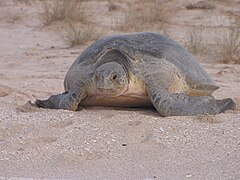|
Ras al-Jinz Location of Ras al-Jinz Raʾs al-Jinz (Arabic: رَأْس ٱلْجِنْز; formerly known as Cape Rosalgate as named by the Portuguese, a corruption of Raʾs al-Hadd; Arabic: رَأْس ٱلْحَدّ[1]) or Raʾs al-Junayz (Arabic: رَأْس ٱلْجُنَيْز), located in Ash-Sharqiyyah South Governorate, Oman, is the easternmost point of the Arabian Peninsula. It is a nesting site for green turtles, as also is the beach at the local village of Ras al Hadd.[2][3] It is home to a well-known turtle reserve. Important archaeological discoveries have also been made at this site, demonstrating connections to the Indus Valley in ancient times. Bronze Age harbourAt Ras al-Jinz, since 1985, a Bronze Age (approximately 2200 to 1900 BC) harbour site has been excavated by a Franco-Italian team.[4] There was a large mudbrick building with seven rooms. These rooms opened onto a corridor. The building seems to have served as a manufacturing workshop. There is evidence of processing of shellfish, turtle shell, flint, and the cosmetics, which was extracted from magnesium ore.[5] Among the finds, about 20% of the ceramics came from the Indus Valley culture. There were also ceramic fragments inscribed with the Indus script symbols.[5][6] Among the Indus wares, large ceramic jars were found in Oman. Their presence at Ras Al Jinz is seen as a clear indication of overseas trade. Thus, during the 3d millennium BCE, Oman[7] must have been part of a great trading systems linked with the Indian Ocean. These jars as interpreted as cargo-shipment containers for dry goods being transported over water.[8] Remains of boatsThe discovery of impressed bitumen fragments and slabs at the site provides information on procedures for reed and wooden boat construction. These objects are dated to the mid-3d millennium BCE.[8] The bitumen pieces carry traces of ropes, reed mats, reed bundles and other details of boat construction. Many of them are also encrusted with sea barnacles. Based on these finds, a mid-3rd millennium 12-m long boat replica was built and tested. These are the indications that this was a Bronze Age port serving the ships from the Indus Valley. Ras al-Jinz still remains an important landmark for merchant ships coming from Pakistan and India.[8] MetallurgyCopper smelting and metal working workshops dating to 3000-1200 BCE have also been discovered.[8] Gallery
See alsoReferences
External linksWikimedia Commons has media related to Ras al-Jinz. Information related to Ras al-Jinz |




